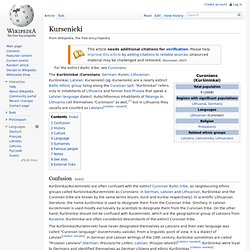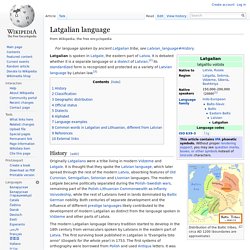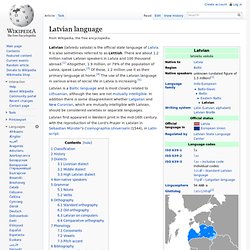Baltic languages
> Indo-European languages
Samogitian dialect. Samogitian (Samogitian: Žemaitiu ruoda, Lithuanian: Žemaičių tarmė) is a dialect[2] of the Lithuanian language spoken mostly in Samogitia (in the western part of Lithuania).

Attempts have been made to standardize it.
Lithuanian language. History[edit] Area of the Lithuanian language in the 16th century The oldest surviving manuscript in Lithuanian (around 1503), rewritten from 15th century original text A map of European languages (1741) with the first verse of the Lord's Prayer in Lithuanian Distribution of the Baltic tribes, circa 1200 CE (boundaries are approximate).

Anyone wishing to hear how Indo-Europeans spoke should come and listen to a Lithuanian peasant. Lithuanian and other Baltic languages passed through a Proto-Balto-Slavic stage, from which Baltic languages retain numerous exclusive and non-exclusive lexical, morphological, phonological and accentual isoglosses in common with the Slavic languages, which represent their closest living Indo-European relatives. According to some glottochronological speculations,[citation needed] the Eastern Baltic languages split from the Western Baltic ones between AD 400 and AD 600.
Kursenieki. For the extinct Baltic tribe, see Curonians.

The Kuršininkai (Curonians; German: Kuren; Lithuanian: Kuršininkai; Latvian: Kursenieki) (sg. Kursenieks) are a nearly extinct Baltic ethnic group living along the Curonian Spit. "Kuršininkai" refers only to inhabitants of Lithuania and former East Prussia that speak a Latvian language dialect. Autochthonous inhabitants of Palanga in Lithuania call themselves "Curonians" as well,[1] but in Lithuania they usually are counted as Latvians[citation needed].
Confusion[edit]
Latgalian language. Distribution of the Baltic tribes, circa AD 1200 (boundaries are approximate).

Latgalian is spoken in Latgale, the eastern part of Latvia. It is debated whether it is a separate language or a dialect of Latvian.[2] Its standardized form is recognized and protected as a variety of Latvian language by Latvian law.[3] History[edit]
Latvian language. Latvian (latviešu valoda) is the official state language of Latvia.

It is also sometimes referred to as Lettish. There are about 1.2 million native Latvian speakers in Latvia and 100 thousand abroad.[1] Altogether, 1.9 million, or 79% of the population of Latvia, speak Latvian.[3] Of those, 1.2 million use it as their primary language at home.[4] The use of the Latvian language in various areas of social life in Latvia is increasing.[5] Latvian is a Baltic language and is most closely related to Lithuanian, although the two are not mutually intelligible. In addition there is some disagreement whether Latgalian and New Curonian, which are mutually intelligible with Latvian, should be considered varieties or separate languages.
Sudovian language. History[edit] Distribution of the Baltic tribes, circa 1200 CE (boundaries are approximate).

Sudovia and neighboring Galindia were two Baltic tribes or nations mentioned by the Greek geographer Ptolemy in the 2nd century AD as Galindai and Soudinoi, (Γαλίνδαι, Σουδινοί). Although Sudovian and Yotvingian were separate dialects of the same language, Sudovian and Yotvingian merged as a common dialect in the 10th century when the two nations created a Federation together with the Denowe – Dainavians. Peter of Dusburg, in his 14th-century Chronicon Terrae Prussiae, refers to Sudovia and to its inhabitants as Sudovites.
Old Prussian language. Distribution of the Baltic tribes, circa 1200 CE (boundaries are approximate).

The language is called Old Prussian to avoid confusion with the German dialects Low Prussian and High Prussian, and the adjective Prussian, which is also often used to relate to the later German state. Old Prussian began to be written down in the Latin alphabet in about the 13th century.
Nadruvian language. Curonian language. Distribution of the Baltic tribes, circa 1200 CE (boundaries are approximate).

The Curonian language (German: Kurisch; Latvian: kuršu valoda; Lithuanian: kuršių kalba), or Old Curonian, is a nearly unattested, extinct language spoken by the Curonians, a Baltic tribe who inhabited the Courland Peninsula (now western Latvia) and the nearby Baltic shore. Curonian was a Baltic language,[1] some scholars consider it to have been an Eastern Baltic, intermediate between Lithuanian and Latvian,[2] while others like Vytautas Mažiulis classify it as Western Baltic.[3]
Semigallian language. Galindian language. Baltic languages. Selonian language. Russian language. Russian (ру́сский язы́к, russkij jazyk, pronounced [ˈruskʲɪj jɪˈzɨk]) is a Slavic language spoken primarily in the Russian Federation, Belarus, Kazakhstan, and Kyrgyzstan. It is an unofficial but widely spoken language in Ukraine, Moldova, Latvia, Lithuania, Estonia, and to a lesser extent, the other countries that were once constituent republics of the Soviet Union and former participants of the Eastern Bloc.[22][23] Russian belongs to the family of Indo-European languages and is one of the three living members of the East Slavic languages.
Written examples of Old East Slavonic are attested from the 10th century onwards.
Skalvians. The Scalovians (German: Schalauer; Lithuanian: Skalviai), also known as the Skalvians, Schalwen and Schalmen, were a Baltic tribe related to the Prussians.

According to the Chronicon terrae Prussiae of Peter of Dusburg, the now extinct Scalovians inhabited the land of Scalovia south of the Curonians and Samogitians, by the lower Neman River ca. 1240. Geography[edit] Name[edit] History[edit] The inhabitants can be traced back to burial grounds with cremated remains and occasional graves of horses.









